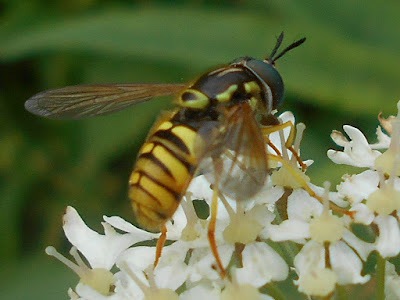 |
| Woodford Halse Pocket Park, looking west. 26 June, 2016 |
It had been my firm intention to take a good look at the spider fauna but, such huge numbers of insects were present that the former ended up getting scant attention.
There was no obvious water present but a male Beautiful Demoiselle, Calopteryx virgo, was patrolling an area near the entrance, doubtless prepared to drive off rivals or attract a female.
This is less common than the Banded Demoiselle and has its Northants stronghold here in the west of the county.
Hogweed, Heracleum sphondylium, was flowering in quantity and its umbels were attracting huge numbers of insects, mostly commonplace but none the worse for that.
 |
| Beautiful Demoiselle on hogweed leaf. Woodford Halse Pocket Park, 26 June, 2016 |
| Volucella pellucens (male) on hogweed umbel. Woodford Halse Pocket Park, 26 June, 2016 |
The hoverfly, Volucella pellucens, was represented by large numbers of individuals. It is not rare but with its striking white band across the abdomen this rather large fly frequently causes comment.
 |
| Male Chrysotoxum bicinctum, Woodford Halse Pocket Park, 26 June, 2016 |
Perhaps slightly less common, and this time with a broken yellow band, is Chrysotoxum bicinctum. The word 'bicinctum. means 'twice girdled' and, in common with the previous species, has black areas on the wings.
A third interesting species of hoverfly was the wasp mimic, Chrysotoxum verralli, again not rare but I do not see it every year. All three species seemed confined to the hogweed even though many other plants were in flower.
 |
Another Chrysotoxum species was C. verralli. Woodford Halse
Pocket Park. 26
|
I was pleased to see the blooms of Field Scabious, Knautia arvensis. It was very much a flower of my childhood (when it was known as Scabiosa arvensis) occurring commonly in pastures. It now seem more likely to be seen on roadside verges or on wasteland, but wherever it is seen it is a welcome sight - and popular with insects too. Although it looks daisy-like it is, as a member of the Dipsaceae, related to teasels.
 |
Field Scabious was occasional, here being visited by a Dance Fly.
Woodford Halse Pocket Park. 26 June, 2016
|
Rather similar in appearance is Greater Knapweed, and its Latin name of Centaurea scabiosa reflects that similarity. But this is a superficial likeness and it is placed in the Daisy Family, Asteraceae. It too is much visited by insects. My herbal recommends it as a tonic. (In the index to my herbal it is placed, rather disconcertingly, near to Knobweed. This is apparently another name for Collinsonia canadensis. How Knobweed is used medicinally I do not know - nor do I wish to!)
 |
Greater Knapweed at Woodford Halse Pocket Park.
26 June, 2016
|
Rather surprisingly there were only a few butterflies on the wing.
 |
Meadow Browns are brown - and live in meadows. Woodford Halse
Pocket Park. 26 June, 2016
|
Predictably the Meadow Brown, Maniola jurtina, was quite frequent, but otherwise one Speckled Wood and a few Common Blues were all I noted, the latter doubtless attracted by Bird's Foot Trefoils and various clovers.
What of other species? The smart mirid bug, Grypocoris stysi, was common, again on Hogweed, together with a host of 'small fry'.
What of other species? The smart mirid bug, Grypocoris stysi, was common, again on Hogweed, together with a host of 'small fry'.
 |
Grypocoris stysi. A common but attractive bug. Woodford Halse
Pocket Park. 26 June, 2016
|
These will take several days to identify. And all this was from only one half of the reserve. The remaining area will require a further visit and in all several trips will be required.


No comments:
Post a Comment